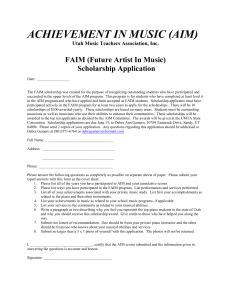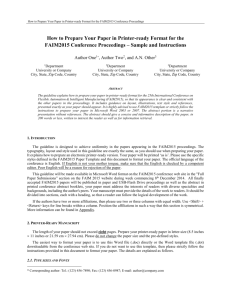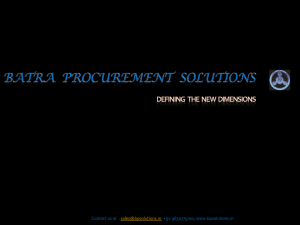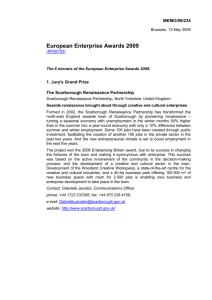High - University of Nebraska–Lincoln
advertisement
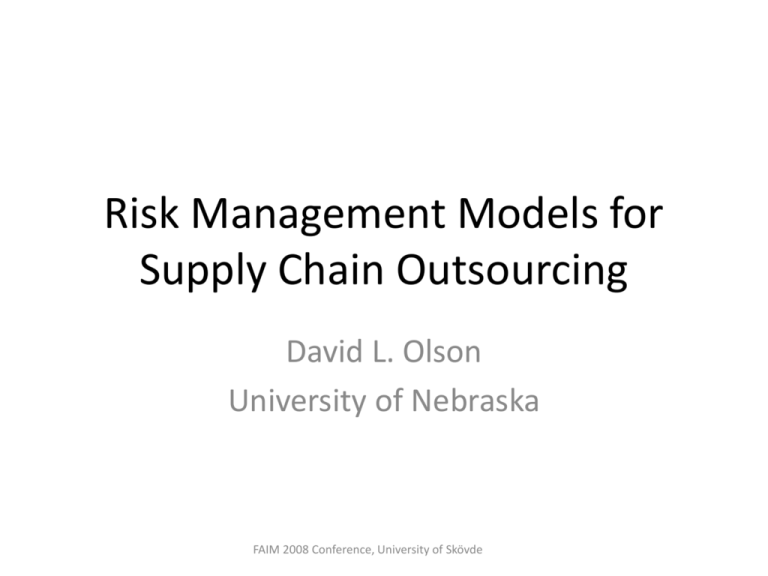
Risk Management Models for
Supply Chain Outsourcing
David L. Olson
University of Nebraska
FAIM 2008 Conference, University of Skövde
Risk & Business
• Taking risk is fundamental to doing business
– Insurance
• Lloyd’s of London
– Hedging
• Risk exchange swaps
• Derivatives/options
• Catastrophe equity puts (cat-e-puts)
– ERM seeks to rationally manage these risks
• Be a Risk Shaper
FAIM 2008 Conference, University of Skövde
Enterprise Risk Management
Definition
• Systematic, integrated approach
– Manage all risks facing organization
•
External
–
–
–
–
–
•
Economic (market - price, demand change)
Financial (insurance, currency exchange)
Political/Legal
Technological
Demographic
Internal
–
–
–
–
Human error
Fraud
Systems failure
Disrupted production
• Means to anticipate, measure, control risk
FAIM 2008 Conference, University of Skövde
Supply Chain Perspective of ERM
• Historical vertical integration
– Standard Oil, US Steel, Alcoa
– Traditional military
• Control all aspects of the supply chain
• Contemporary
– Cooperative effort
• Common standards
• High competition
• Specialization
– Internet
• Service oriented architecture
FAIM 2008 Conference, University of Skövde
Supply Chain Problems
• Land Rover
– Key supplier insolvent, laid off 1000
• Dole 1998
– Hurricane Mitch hit banana plantations
• Ford
– 9/11/2001 suspended air delivery, closed 5 plants
• 1997 Indonesian Rupiah devalued 50%
– Blocked out of US supply chains
– Jakarta public transport reduced operations, high repair
parts
– Li & Fung shifted production from Indonesia to other Asian
sources
FAIM 2008 Conference, University of Skövde
More Problems
• Taiwan earthquake 1999
– Dell & Apple supply chains short components a few
weeks
• Apple had shortages
• Dell avoided problems through price incentives on
alternatives
• Philips semiconductor plant in New Mexico burnt
2000
– Ericsson lost sales revenue
– Nokia had designed modular components, obtained
alternative chips
FAIM 2008 Conference, University of Skövde
Supply Chain Risk Sources
• Giunipero, Aly Eltantawy [2004]
–
–
–
–
–
–
–
–
–
Political events
Product availability
Distance from source
Industry capacity
Demand fluctuation
Technology change
Labor market change
Financial instability
Management turnover
FAIM 2008 Conference, University of
Skövde
Robust Strategies
Tang [2006]
•
•
•
•
Postponement – standardization, commonality, modular design
Strategic stock – safety stock for strategic items only
Flexible supply base – avoid sole sourcing
Economic supply incentives – subsidize key items, such as flu
vaccine
•
•
•
•
Flexible transportation – multi-carrier systems, alliances
Dynamic pricing & promotion – yield management
Dynamic assortment planning – influence demand
Silent product rollover – slow product introduction - Zara
FAIM 2008 Conference, University of Skövde
Supply Chain Risks & Outsourcing
RISK
Elaboration
Impact
Accounting
Risk of ruin
High
Asset investment
Asset utilization
Increase risk to core
Country risk
Most innovative supplier may be in risky
country
Competitive risk
Need to differentiate Outsource products available to
competitors
Customer risk
Product
obsolescence
Low quality drives out customers;
Outsourcing reduces risk of obsolescence
Downside risk
Risk of failure
Can replace outsource vendors
Financial risk
Financial market risk
Core less threatened by outsourced vendor
failure
Interaction
Communication,
coordination
Outsourced vendors more independent;
Can impose IT requirements
FAIM 2008 Conference, University of Skövde
Continued
RISK
Elaboration
Legal risk
Litigation exposure Risk shifted to outsourcing vendor
Product risk
Product technical
complexity
Regulatory risk
Reputation risk
Impact
Core needs to assure outsourcing vendor
competent
Outsourcing vendors assume local risk
Customer
confidence
Higher to core, as customers hold them
responsible
Shared risk
Outsourcing allows access to market of
vendors
Supplier risk
Smaller organizations have greater risk
Supply
disruption
If outsourcing vendor fails, have alternatives
FAIM 2008 Conference, University of Skövde
Early Supplier Involvement
Risk to Core
• Vertical cooperation – design & concept
–
–
–
–
Reduce development time
Better product quality
Improved costs
RISKS: sequencing, shortages, incapable suppliers
• ROLLS ROYCE Aerospace
– New product development 3-4 years
– ESI 1999
– SUPPLY COST REDUCTION:
• Reduced threat of excessive costs, easier to handle changes
• Reduced legal liabilities, fewer quality problems
• Less supplier capacity constraints, shorter development time
FAIM 2008 Conference, University of Skövde
Vendor Risk
Risk to Suppliers
• Disintermediation – US gas stations
• Motokov UK Ltd.
– European importer/distributor in agricultural market, tires
– Selected by Italian agricultural machinery manufacturer
Landini to market Zetor tractors
• For 3 ½ years, exclusive UK distributor
• Then Landini formed an internal distributor
– Tires
• Mid-1990s dropped Matador Tyres for a Czech tire company
• 1995 Czech company went under, back to Matador
• 2002 Matador dumped Motokov
– Zetor Tractors (Czech)
• Production halted after dropped Communism
FAIM 2008 Conference, University of Skövde
Risk Management Tools
• Simulation (Beneda [2005])
– Monte Carlo – Crystal Ball
• Multiple criteria optimization (Dash & Kajiji
[2005])
– Goal programming - tradeoffs
• SYSTEMS FAILURE METHOD
– Information Systems Project Management
• INFORMATION TECHNOLOGY
FAIM 2008 Conference, University of Skövde
Monte Carlo Simulation
Quoted
price
Exchange
distribution
Product
failure
Organizatio
nal failure
China
0.82
No(1.3,.2)
0.10
0.15
0.05
2.13
Taiwan
1.36
No(1.03,.02)
0.01
0.01
0.10
1.81
Vietnam
0.85
No(1.1,.1)
0.15
0.25
0.05
2.51
Germany
3.20
No(1.05,.02)
0.01
0.02
0.01
3.43
Alabama
2.05
1
0.03
0.20
0.03
2.78
FAIM 2008 Conference, University of Skövde
Political
failure
Expected
price
China vendor price distribution
FAIM 2008 Conference, University of Skövde
Taiwan vendor price distribution
FAIM 2008 Conference, University of Skövde
Simulation Output
Mean cost
Min cost
Prob{failure}
Prob{low}
China
2.06
0.54
0.253
0.406
Taiwan
1.84
1.30
0.123
0.103
Vietnam
2.60
0.58
0.410
0.479
Germany
3.43
3.14
0.040
0.003
Alabama
2.05
2.05
0.254
0.009
FAIM 2008 Conference, University of Skövde
MCDM
j alternatives, I criteria
weights, scores
value j wi u xij
K
i 1
FAIM 2008 Conference, University of Skövde
MCDM Weights
Criteria
Base 100
Base 10
Best (100)
Worst (10)
Average
Quality
100
60
0.2299
0.2308
0.23
Experience
90
55
0.2069
0.2115
0.21
Cost
85
50
0.1954
0.1923
0.19
Flexibility
60
40
0.1379
0.1538
0.14
Technical
50
30
0.1149
0.1154
0.11
Exchange
30
15
0.0690
0.0577
0.06
Capital
20
10
0.0460
0.0385
0.06
435
260
FAIM 2008 Conference, University of Skövde
Scores
Quality
Experience
Cost
Flexibility
Technical Exchange
Capital
China
Problems
2 years
0.82
High
Average
High
Weak
Taiwan
High
17 years
1.36
High
High
Moderate
High
Vietnam
Concerns
1 year
0.85
Low
Low
Moderate
Weak
Germany
High
5 years
3.20
Low
High
Moderate
High
Alabama
good
7 years
2.05
Low
High
None
Average
China
0.20
0.30
1.00
1.00
0.60
0.00
0.20
Taiwan
1.00
1.00
0.50
1.00
1.00
0.50
1.00
Vietnam
0.40
0.10
0.95
0.20
0.20
0.50
0.20
Germany
1.00
0.70
0.00
0.20
1.00
0.50
1.00
Alabama
0.70
0.90
0.30
0.20
1.00
1.00
0.50
FAIM 2008 Conference, University of Skövde
Values
Criteria
Weights
CHINA
TAIWAN
VIETNAM
Quality
0.23
0.20
1.00
0.40
1.00
0.70
Experience
0.21
0.30
1.00
0.10
0.70
0.90
Cost
0.19
1.00
0.50
0.95
0.00
0.30
Flexibility
0.14
1.00
1.00
0.20
0.20
0.20
Technical
0.11
0.60
1.00
0.20
1.00
1.00
Exchange
0.06
0.00
0.50
0.50
0.50
1.00
Capital
0.06
0.20
1.00
0.20
1.00
0.50
Score
0.52
0.88
0.39
0.61
0.64
Rank
4
1
5
3
2
FAIM 2008 Conference, University of Skövde
GERMANY
ALABAMA
Balanced Scorecard
Perspectives
Goals
Measures
Financial
Survive
Succeed
Prosper
Cash flow
Sales, growth, income
Increase in Market share, ROI
Customer
New products
Responsive supply
Preferred suppliers
Customer partnerships
% sales new products
On-time delivery
Share of key accounts’ purchases
# Cooperative engineering efforts
Internal
business
Technology capability
Manufacturing experience
Design productivity
New product innovation
Benchmark vs. competition
Cycle time, unit cost, yield
Engineering efficiency
Planned vs. actual schedule
Innovation &
learning
Technology leadership
Manufacturing learning
Product focus
Time to market
Time to develop next generation
Process time to maturity
% products yielding 80% sales
New product innovation vs. competition
FAIM 2008 Conference, University of Skövde
Conclusions
• Outsourcing provides competitive access
– Broader opportunities
• Demonstrate 3 tools
– Monte Carlo simulation
• Evaluate probabilistic elements
– MCDM
• Consider multiple criteria
• Select vendor by decision maker preference
– Balanced Scorecard
• Measure effectiveness of selected vendor
FAIM 2008 Conference, University of Skövde
